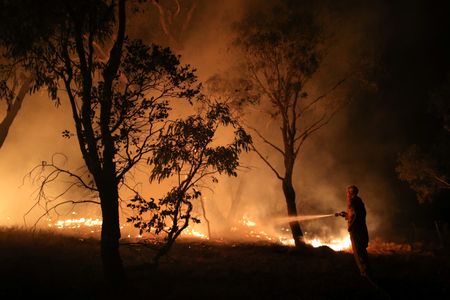By Peter Hobson and Renju Jose
CANBERRA (Reuters) – Australia will suffer more frequent and extreme climate events, often happening simultaneously, which will strain industry, services and infrastructure, a government report said on Monday, ahead of the announcement of a new emissions target.
Among the conclusions of the most comprehensive assessment of risks to Australia posed by climate change were that heatwaves will become more frequent and deadly, while rising sea levels will put millions at risk and plants and animals will have to move, adapt or die.
Northern parts of the country, remote communities and outer suburbs of major cities will be particularly susceptible, Climate and Energy Minister Chris Bowen said in a statement.
“No Australian community will be immune from climate risks that will be cascading, compounding and concurrent,” he said.
“Australians are already living with the consequences of climate change today, but it’s clear every degree of warming we prevent now will help future generations avoid the worst impacts in years to come.”
Australia aims to cut carbon emissions by 43% by 2030 and reach net-zero emissions by 2050. Bowen said the government would soon announce an “ambitious and achievable” emissions reduction target for 2035.
The previous right-of-centre government was considered by clean energy advocates a global laggard for its emissions policies. Renewable energy projects have faced backlash from communities and conservative politicians and media.
Opposition leader Sussan Ley said Australia should cut emissions but not at any cost and the government should avoid alarmist language.
“Any (emissions reduction) target must pass two simple tests: it must be credible, and it must be upfront about the cost to households and small businesses,” she said in a statement.
Australia is a major exporter of natural gas and coal. The government last week gave the go-ahead for the country’s second-largest liquefied natural gas plant to operate until 2070.
Monday’s report said Australia was already 1.2 degrees Celsius warmer than historical levels. It said a 3-degree warming would raise the number of extreme heatwave days to 18 a year from four now and the duration of marine heatwaves to nearly 200 days from 18 now.
The number of deaths from heatwaves in Sydney could increase by 444% in that scenario, it said, while some forests and marine life may perish.
Three degrees of warming would raise sea levels by another 54 centimetres by 2090, allowing saltwater ingress to impact fresh water supply and putting more than 3 million people in coastal communities at high risk of flooding.
Health and emergency services would face pressure, rebuilding costs would rise, property values would fall and hotter, drier weather would damage crop yields and stress livestock, the report said.
The government also on Monday released a national adaptation plan that Bowen said would guide Australia’s response to the report’s findings.
“Our whole country has a lot at stake,” Bowen said. “This report is a reminder, if we needed one, that the cost of inaction will always outweigh the cost of action.”
(Reporting by Peter Hobson in Canberra and Renju Jose in Sydney; Editing by Jamie Freed and Lincoln Feast.)












